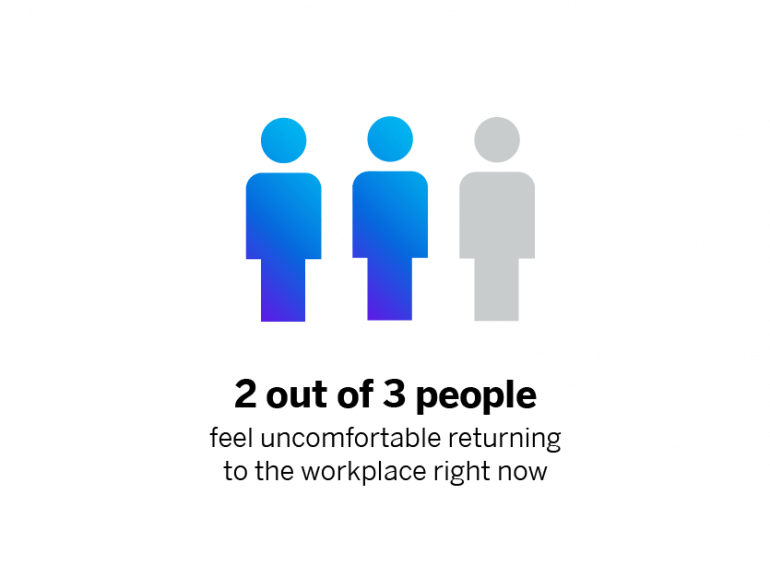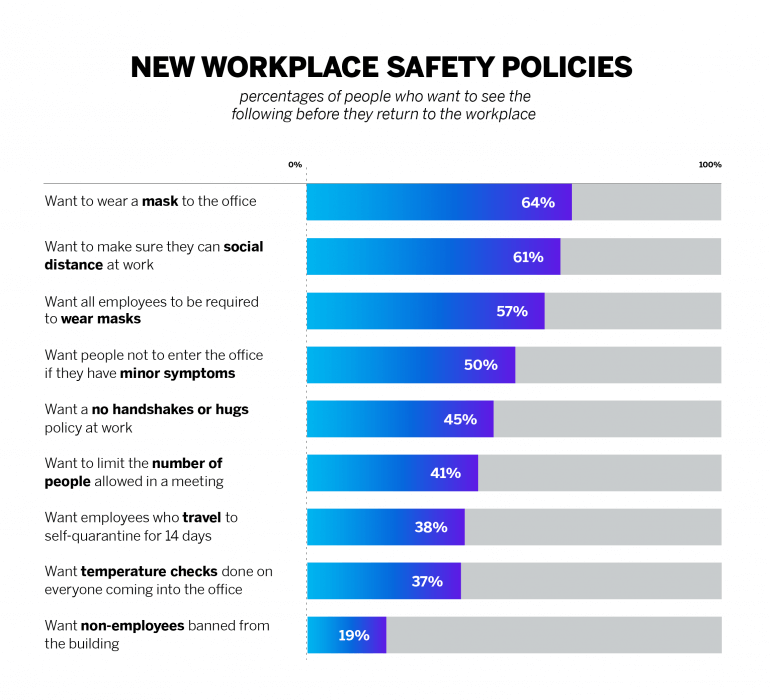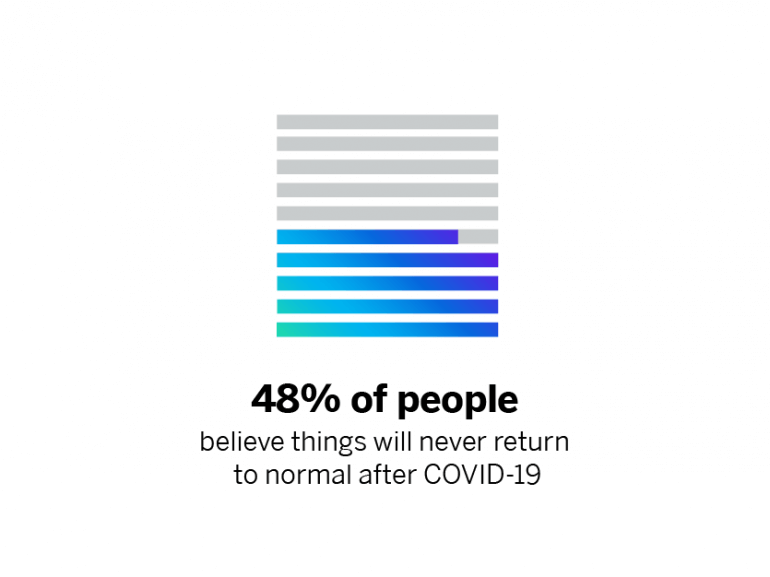Customer Experience
Is America ready to return to work and get back to business?
Most U.S. states are making plans to reopen as the country struggles to recover from the COVID-19 pandemic. But as governments and businesses move forward, the question remains: Are Americans ready?
And perhaps more importantly: What do they need to feel ready?
We asked more than 2,000 U.S. residents at the end of April whether they were comfortable returning to the workplace, dining at restaurants, voting at polling places, and visiting other public spaces. Here’s what they say needs to happen before they feel ready to go back.
Click here to download a PDF summary of the study
Return to Work
Two out of three people (66%) are not comfortable going back to the workplace right now. In fact, workers of all ages — from Boomers to Gen Z — are equally wary about returning to shared work spaces, with more than 65% in every age group reporting that they were uncomfortable doing so.

- A quarter of employees (25%) expect to return to the workplace some time in May, while 28% believe they’ll be going back in June. Nearly half (48%) don’t expect to return to work until August or later.
- Workers in the Midwest are 44% more likely to be comfortable returning to work right now than those in the Northeast, though 62% of Midwesterners overall say they’re still uncomfortable with the idea. The South is slightly more uncomfortable at returning to work (67%) than the West (62%).
- Republicans are two times more likely than Democrats to say they’re comfortable returning, though still only 34% of Republicans say they’re comfortable going back to the workplace.
What would make people feel comfortable returning to work?
Most employees want assurance from public health officials like the Centers for Disease Control (63%) or the World Health Organization (45%) to feel comfortable returning to the workplace. About half say they’d be comforted if their state or local governments say it was safe, while medical interventions, like a treatment or vaccine, would also ease worries. Only 42% say they’d feel safer if federal government officials said it was safe.

Once those criteria are met, however, workers want to see a few more things happen before they feel confident coming back:
- 39% want the ability to maintain social distancing at work (6 feet between people)
- 27% want their company leadership to deem it safe to come back
- 22% want transit options that are sanitary and safe
- 20% want schools and childcare facilities to open back up
People want their company to take action
People also expect their employers to keep them safe at work once they come back, with 69% saying they trust their company leadership to make the best decision on when employees should return to work, 16% reporting that they were neutral, and 15% who disagree.
But they also expect additional safety measures from their company leadership:
- 74% want their work facility to be thoroughly and regularly cleaned and disinfected
- 63% want their company to consult with local and state authorities to make sure it’s safe to come back
- 62% want strict policies about who cannot come to the office, like those who are sick or have recently traveled
- 57% want masks available to anyone who wants one
People want to be able to take action
Two out of three people (64%) say they want to be able to wear a mask at work, while nearly as many (61%) want to maintain social distancing. Half want more flexible sick-leave policies, which employees are encouraged to use, even if they only have minor symptoms.
Employees want to be able to do the following when they return to work:
- 64% want to be able to wear a mask at work
- 61% want to maintain social distancing
- 50% say they want more flexible sick-leave policies, which employees are encouraged to utilize, even with minor symptoms
- 49% want to be able to limit the number of people they’re exposed to in workplace meetings
- 43% want their temperatures checked before entering the building
- 37% want to be allowed to skip work without penalty if they feel unsafe
- 36% want to to be able to continue working from home if they don’t feel safe in the office
People want their co-workers to take action
Workers are worried, not only about their own safety, but about the safety of their co-workers. They also understand that their co-workers health affects their own, and many want safety policies put into place before returning to work — like a temporary ban on handshakes and hugs (45%), or a policy that requires employees who travel for work or pleasure to self-quarantine for 14 days (38%).
- 70% want hand sanitizer and cleaning supplies available at all times throughout the office
- 57% want all employees to be required to wear a mask all of the time
- 50% want social distancing implemented at work
- 47% want employees to be required to wear a mask, even if they have minor symptoms
- 45% want a no handshakes/hugs policy at work
- 42% want those with health issues or other reasons they shouldn’t come in to be allowed to work from home
- 41% want limits on the number of people who can attend a meeting
- 39% want serious safety measures around any communal food
- 38% want employees who travel for work or pleasure to have to self-quarantine for 14 days
- 37% want people to be brought back in phases instead of all at once.
Understand your employees' safety needs with our complimentary solution
Back to Business
Consumers have delayed significant purchases since the beginning of March, with more than half (52%) saying they would have spent money on clothing or travel expenses had the pandemic not disrupted their plans, and 15% saying they would have spent money on a house.
- 52% say they would have spent money on clothing
- 52% say they would have spent money on travel expenses (flights, hotels etc.)
- 37% say they would have spent money on event tickets
- 26% say they would have spent money on home furnishings or appliances
- 22% say they would have spent money on a car
- 20% say they would have spent money on a gym or personal trainer
- 19% say they would have spent money on home renovations or improvements
- 15% say they would have spent money on a house
And even though many might return to work soon, it may be awhile yet before people feel comfortable sitting down at a restaurant, going to the gym, taking a flight or visiting other public spaces.

Almost half of respondents (48%) say they don’t think things will ever “get back to normal.” And people still feel pretty uncomfortable sharing a physical space with others, especially strangers.
- 79% say they would feel uncomfortable attending a live sporting event
- 78% say they would feel uncomfortable attending a live concert
- 77% say they would feel uncomfortable riding public transportation
- 75% say they would feel uncomfortable going on a flight
- 71% say they would feel uncomfortable going to the gym
- 68% say they would feel uncomfortable eating at a restaurant
- 66% say they would feel uncomfortable attending a live training or conference
- 62% say they would feel uncomfortable staying in a motel or hotel
People also don’t yet feel confident interacting with each other: 68% of respondents say they would feel uncomfortable playing a team sport, 60% say they wouldn’t want to attend a religious service, and 51% say they would still feel uncomfortable going to a retail store — though only 38% say they would feel uncomfortable shopping for groceries.
What would make people feel comfortable getting back to businesses?
Live events
People feel most uncomfortable attending live events. Of those who regularly attend live concerts, 26% say they are unlikely to return in the foreseeable future, and 24% of those who attend sporting events say the same.
In fact, 58% say they wouldn’t feel comfortable attending a live sporting event until September 1 or later and 33% say not until January 2021. Even more feel the same about live concerts, with 61% saying they wouldn’t feel comfortable attending a concert until September 1 or later and 38% saying not until January 2021.
Even after public health officials say it’s safe, and a treatment or vaccine for the virus is readily available, people want to see a few other things happen before they feel comfortable attending a live concert, sporting event or conference:
- 39% want social distancing established and enforced at the event
- 36% want mandatory mask-wearing
- 33% want assigned seating with attendees kept at a safe distance
- 29% want temperature checks done on all those attending the event
Restaurants
Though restaurants will partially reopen as states move forward, 68% of people say they would feel uncomfortable eating at a restaurant right now, and 16% say they’re unlikely to dine in at all in the foreseeable future.
Right now, 42% of people say they wouldn’t feel comfortable eating in a restaurant until September 1 or later, and 20% say not until January 2021.
Even after public health officials say it’s safe, and a treatment or vaccine for the virus is readily available, people want to see a few other things happen before they feel comfortable eating at a restaurant:
- 36% want tables separated at a safe distance
- 36% want social distancing established
- 33% want servers and staff to wear gloves and masks
- 21% want their temperatures checked before going into the restaurant
Flights and public transit
Before asking people to return to work, companies will have to ensure their employees are safe and comfortable traveling on public transit. And the same applies to travel for work: 77% of people feel uncomfortable taking public transit right now, and 75% feel uncomfortable flying on an airplane. And 20% of those who say they regularly fly believe they’re unlikely to do so in the foreseeable future.
People do, however, feel more comfortable traveling for work than they do for pleasure, with 17% saying they would be comfortable traveling for work right now, but only 9% saying they’d be comfortable traveling for pleasure. Similarly, 13% say they’d be comfortable staying at a hotel for work right now, while 9% say they’d feel comfortable doing so for pleasure.
Even after public health officials say it’s safe, and a treatment or vaccine for the virus is readily available, people want to see a few other things happen before they feel comfortable flying or taking public transportation:
- 40% want masks to be mandatory for every passenger
- 38% want assigned seating with passengers spaced at least 6 feet apart
- 37% want the boarding and unloading of passengers done in a way that maintains separation
- 32% want the temperatures of passengers checked before they board
Polling places
As states begin to open for business and the primary election process continues, 60% of respondents say they would be uncomfortable voting in-person at a polling place right now.
For public officials working to make in-person voting safe, research shows that after public health officials say it’s safe to do so, people will feel more comfortable in polling places with the following measures in place:
- 34% want mandatory masks for everyone
- 33% say they want social distancing established
- 32% want booths sanitized between every voter
- 22% want temperature checks done on all involved
Return to work and back to business
Though many states are moving ahead to reopen, it’s clear Americans don’t feel quite ready to go back — to work or business. As employers make plans to return to the workplace, they’ll need to carefully gauge how employees feel and what would make them comfortable. And as businesses reopen, they’ll want to do the same with their customers.
========
To help businesses and employers return to work and get back to business, Qualtrics created the Return to Work Pulse, an automated solution that allows leaders to listen, understand, and act on employees’ health and safety needs, as well as the Back to Business solutions, which are designed to help organizations stay connected with customers and take actions to build customer confidence.
Understand your customers' safety needs with our complimentary solution
